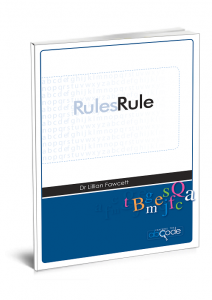Sample of the General Knowledge section: Multisensory Reading Program Level 4. 
The General Knowledge section provides the knowledge required for Stage 3 literacy development outlined in Frith’s (as cited in Heath, Hogben, & Tan, 2008) literacy acquisition model (i.e., orthographic knowledge). This type of orthographic knowledge tends to be an area of weakness for adolescents and adults with dyslexia or poor reading and spelling (see Holmes & Quinn, 2009).
- The sophisticated words in English are often those derived from Greek and Latin. An understanding of the meaning of key root words makes spelling and reading easier as well as enriching the student’s knowledge of English. For example, ject = to throw.
- Prefixes are fixed in front of a word (pre=before). The prefix changes or adds meaning to the root word. For example, pro = forward or ahead. Therefore, proceed = go forward.
- Suffixes are fixed to the end of a word (suf=end). The suffix changes the word from one part of speech to another. For example, or = person who or thing that. Therefore, teacher = a person who teaches (i.e., it is changing the verb ‘teach’ into a noun ‘teacher’).
- Students use their knowledge of root words and affixes to match the words with the correct definition.
- A noun is a word that names an object, a person, an animal, a place, a ‘thing’ or a feeling. ‘A’ (or an) and ‘the’ can be placed in front and it can be pluralised. A collective noun is the word given to describe a group of nouns (e.g., a group of students=a class; a group of baboons = a troop).
- A proverb is a short traditional saying that expresses a common belief or truth based on common sense or practical experience. Proverbs often have a different meaning to their literal meaning. Thus, an understanding of a range of proverbs increases the student’s understanding of the English language. The student is required to change one letter in each word to reveal the proverb. This exercise requires an understanding of common letter patterns and parts of speech.
- An idiom is a phrase or expression that means something different to the literal meaning and usually develops among a particular group of people. Consequently, new idioms are constantly being introduced into the English language.
- A simile is used to compare two things that have something in common and contains the word ‘as’ or ‘like’ in the phrase. The similes in this workbook have been in common usage for many years. It should be stressed that although similes provide interest and clarity in creative writing, they should be original comparisons.
References
Heath, S., Hogben, J., & Tan. V. (2008). Assisting students struggling with spelling. Dyslexia-SPELD Bulletin. 40, 5-7.
Holmes, V., & Quinn, l. (2009) Unexpectedly Poor Spelling and Phonological-Processing Skill. Scientific Studies of Reading.13, 295-310.

Click on the book image to purchase.
“After visiting Lillian weekly for 12 weeks, she found the problems that my daughter had, sorted them, and hey presto English lessons were not something to dread at school. She even made it make sense to me as well.” Julie (Mother) – Bullsbrook. Reading Accuracy Age: Before: 9 years 6 months After: 12 years 6 months
Reading Comprehension Age: Before: 12 years 4 months After: 13 years +++
Spelling Age: Before: 9 years 1 month After: 10 years 3 months
Known graphemes: Before: 21 After: 53
Number of lessons: 12
If you have any questions or need assistance, please send Lillian a message.




